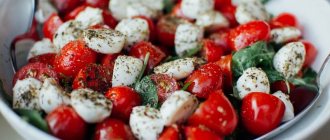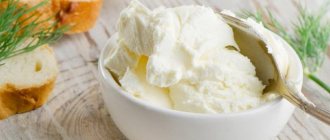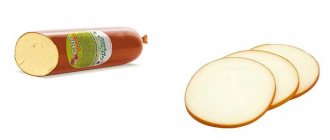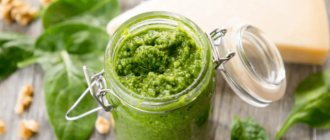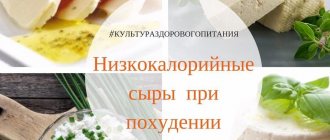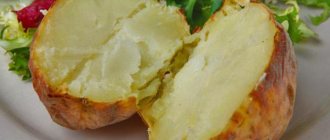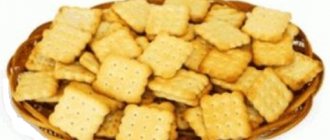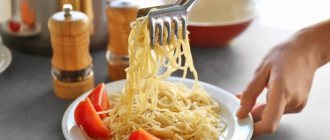Russian cheese is one of the most beloved semi-hard cheeses in our country. This product was “born” at the Research Institute of the Cheese Industry in the 60s of the last century. Once on the shelves, Russian cheese became more and more popular every year.
If immediately after the creation of the recipe, the cheese was produced by only one cheese-making plant in Uglich, then its growing consumption forced the relevant ministry to extend the production technology to many other cheese-making plants and factories in Russia, Belarus, Ukraine and the Baltic countries, which today are the main producers of this type of cheese .
Composition of the product
The fat content of Russian cheese is 50%. At the same time, it contains a lot of protein (21-23 g/100 g) with an average fat content (30-33 g/100 g). The difference in percentage and natural fat content is explained by the fact that its percentage is determined in dry matter, and natural - in the finished product, that is, taking into account its moisture content.
Content:
- Composition of the product
- Production technology
- Beneficial features
- Possible harm
- Use in cooking
- How to select and store
Milk fat is represented to a greater extent by saturated, and to a lesser extent by mono- and polyunsaturated fatty acids. Cheese proteins are complete in nature, that is, they contain all the amino acids essential for the human body.
The composition of the finished product, in addition to proteins and fats, also includes carbohydrates (glucose, lactose), vitamins (group B), minerals and preservatives. The calorie content of this fermented milk product is 364 kcal per 100 g.
Taste and calorie content of Russian cheese
The calorie content of Russian cheese is 363 kcal per 100 grams of product. That's quite a lot. With such a calorie content, cheese can have a negative impact on your figure if you eat it too often and in large quantities.
The taste of the cheese is moderate, slightly sour, not too salty, with a pleasant creamy aftertaste. The structure is elastic, plastic, easy to cut with a knife into cubes or slices, does not crumble or roll. Melts easily.
Advertising - Continued below
Production technology
Russian cheese is produced according to GOST. This is one of those cheeses that is characterized by a high degree of lactic fermentation and a low second heating temperature.
Another peculiarity of the industrial production of this cheese is that mesophilic lactic acid streptococcal starters are used to ferment milk, and during the ripening process the heads change temperature conditions three times (10-12°, 14-16° and again 10-12°C).
The production process includes several successive stages:
- Cleaning and cooling of milk to +6…+8°С (to prevent microbial contamination).
- Maturation of milk (to increase its acidity). To do this, cooled milk is kept for 10-14 hours at a temperature of +10...+12°C.
- Normalization and pasteurization. Milk is normalized by fat, bringing it to the required mass fraction according to the technological instructions. Normalized milk is pasteurized in order to suppress the growth of microbes in it, inhibit existing enzymes and prepare it for coagulation. After pasteurization, the raw material is cooled to the coagulation temperature (32-34°C).
- Curdling of milk. Ferment and calcium chloride solution are added to the prepared milk. Within 25-30 minutes, a clot forms.
- Crushing the clot. After formation, the curd is cut, crushed and kneaded to obtain fine cheese grains. At this stage, about 30% of the whey is removed.
- Second heating. When producing Russian cheese, it lasts 15-30 minutes at a temperature of 38-41°C. The cheese grain is partially salted.
- Dehydration. After heating, the grain is kneaded again for 30-50 minutes. At the same time, its acidity is controlled.
- Head molding. The dried grain is fed into a molding machine to form a layer, which is cut into pieces of the required size. These pieces are placed in molds, in which they are self-pressed for 25-30 minutes. After this, the heads are numbered with plastic numbers.
- Pressing. The formed heads are fed under the press for 1.5-4 hours.
- Salting. Salting of Russian cheese is carried out by immersing the heads in a circulating brine at a temperature of +8...+12°C for 3-5 days.
- Maturation. After salting, the heads are dried (2-3 days) and sent to maturation chambers for 1.5-2.5 months. After they are ripe, the heads are washed, labeled, packaged in plastic film or coated with paraffin.
This long technological process for making Russian cheese gives it a delicate texture and a pleasant sour aftertaste, which sets it apart from other semi-hard varieties. On the cut it has a beautiful fine-bubble pattern.
7 day diet
Quite tough, with serious dietary restrictions, but well tolerated and not accompanied by increased appetite.
In addition to Rossiysky cheese, the diet includes:
- low-starch root vegetables and fruits;
- nuts;
- liquid honey;
- biokefir and bioyogurt;
- lean types of meat, poultry, fish;
- dried fruits.
Approximate diet:
| 1st day | |
| Breakfast |
|
| Snack |
|
| Dinner |
|
| Snack |
|
| Dinner |
|
| 2nd day | |
| Breakfast |
|
| Snack |
|
| Dinner |
|
| Snack |
|
| Dinner |
|
| 3rd day | |
| Breakfast |
|
| Snack |
|
| Dinner |
|
| Afternoon snack |
|
| Dinner |
|
| 4th day | |
| Breakfast |
|
| Snack |
|
| Dinner |
|
| Snack |
|
| Dinner |
|
| 5th day | |
| Breakfast |
|
| Snack |
|
| Dinner |
|
| Snack |
|
| Dinner |
|
| 6th day | |
| Breakfast | Low-fat cottage cheese with bio-yogurt |
| Snack | Fruit salad |
| Dinner | Baked quenelles of minced veal with melted cheese inside |
| Snack | Fruits |
| Dinner | Sandwich with cheese, tomatoes and radishes |
| 7th day | |
| Breakfast |
|
| Snack |
|
| Dinner |
|
| Snack |
|
| Dinner |
|
Before each meal, you should drink 250 ml of warm water to dull the feeling of hunger. The diet must be combined with a sufficient drinking regime, requiring the consumption of 1.5-2 liters of water, herbal infusions (chamomile, rose hips) or any (preferably green) tea. If necessary, it is allowed to dull the appetite with biokefir or bioyogurt.
You can stick to this diet for 3 to 7 days.
Diet "Sandwiches with cheese"
This diet does not have a special menu. For 10 days you should eat only sandwiches with Russian cheese, and the diet should not exceed 1200 kcal in calories.
Diet rules:
- You can eat 1-2 sandwiches per hour;
- for cooking it is allowed to use only grain bread or bread with bran and cheese, cut into thin slices;
- You can supplement your diet with fresh low-calorie vegetables, green salad, parsley;
- You should drink 1.5 liters of water or herbal teas per day.
Women are allowed to eat no more than 14 sandwiches per day, men - 16. If desired, cheese can be melted in the oven, diversifying the diet with hot sandwiches.
Wine and cheese diet
A favorite dietary food among the French, it allows the consumption of various types of cheese with dry red wine.
With this diet, reducing body weight by 3-5 kg requires 5 days of eating only:
- various types of cheese (350 g);
- dry red wine (300 ml);
- grain breads (8-9 pcs.)
Beneficial features
Russian cheese is a source of healthy, complete animal protein. At the same time, in order to fill the daily need for basic essential amino acids, an adult needs to eat only 120-140 g of this delicious fermented milk product, for example, in the form of cheese sandwiches for breakfast.
Consuming it in the morning allows you to level out the fairly high calorie content of cheese.
Being a source of well-absorbed calcium, this product is useful for the musculoskeletal system, especially during such periods of life as childhood, pregnancy, breastfeeding, menopause, and also after injuries to bones or joints.
The acidity of mature cheese is 5.25-5.35 pH, which, with moderate consumption of this product, has a beneficial effect on digestion processes in the intestines. Lactic acid and vitamins help restore normal intestinal microflora, fight intestinal dysbiosis and group B hypovitaminosis.
The rich vitamin and mineral composition of the finished product has a beneficial effect on metabolic processes in the human body, thereby improving brain activity, reproductive function, and the condition of the skin and its appendages.
The iron contained in cheese, together with B vitamins (folic acid, cyanocobalamin), stimulates hematopoiesis, so this product is useful to use for anemia, weakened immunity, exhaustion, after long-term and infectious diseases.
Saturated fatty acids in milk fat are used by the body for the synthesis of cell wall phospholipids, as well as steroid hormones - sex and adrenal hormones.
Possible harm
In addition to its benefits, Russian cheese can also have a harmful effect on the human body. First of all, this concerns its use in large quantities. Its fat and calorie content does not allow it to be called a dietary product, so it should not be included in the daily menu for overweight people, as well as those who are trying to lose weight.
A large amount of protein in cheese increases the load on the pancreas, liver and kidneys, so cheese is not recommended for people suffering from diseases of the pancreas, liver and urinary system. A protein load is fraught with an increase in the level of purines and uric acid in the body, so Russian cheese should not be eaten by people suffering from gout and urolithiasis.
Best materials of the month
- Coronaviruses: SARS-CoV-2 (COVID-19)
- Antibiotics for the prevention and treatment of COVID-19: how effective are they?
- The most common "office" diseases
- Does vodka kill coronavirus?
- How to stay alive on our roads?
Due to the low pH, fermented milk products are contraindicated for use by patients with gastritis with high acidity and ulcers.
Cheese contains a lot of table salt, which is harmful for inflammation of the stomach and intestinal mucosa, and is also harmful for hypertensive patients, so their consumption of this product must be reduced to a minimum.
Use in cooking
Due to the fact that Russian cheese is tasty and affordable, it is widely used in cooking in our country.
The fat content of the product determines its ability to melt well, so it is grated for breading, pizza and casseroles, as well as:
- eaten as a separate snack;
- place on a cheese plate;
- added to salads, appetizers, side dishes;
- soups are made from it;
- used as a filling in baked goods.
This type of cheese, thanks to its delicate sourness, goes well with nuts, olives, grapes, berries, honey, coffee, and wine.
JSC "UMALAT" (Umalat, Unagrande)
| Chocolate ricotta Unagrande Per Bambini, 30% | 228 kcal/954 kJ |
| Ricotta Pretto, 30% | 140 kcal/586 kJ |
| Ricotta Unagrande, 45% | 140 kcal/586 kJ |
| Mozzarella Fior di Latte Unagrande, 50% | 270 kcal/1130 kJ |
| Mozzarella Per Bambini Unagrande, 50% | 270 kcal/1130 kJ |
| Mozzarella Ciliegina Unagrande, 50% | 270 kcal/1130 kJ |
| Mozzarella Fior di Latte Pretto, 45% | 270 kcal/1130 kJ |
| Mozzarella Ciliegina Pretto, 45% | 270 kcal/1130 kJ |
| Mozzarella for pizza, 45% | 297 kcal/ 1242 kJ |
| Mozzarella for panini and hot sandwiches Unagrande, 45% | 297 kcal/1242 kJ |
| Mozzarella for pizza Unagrande, 45% | 297 kcal/1242 kJ |
| Chocolate mascarpone Unagrande Per Bambini, 50% | 411 kcal/1720 kJ |
| Mascarpone Ungrande Professionale, 80% | 416 kcal/1741 kJ |
| Mascarpone Pretto, 80% | 416 kcal/1741 kJ |
| Mascarpone Ungrande, 80% | 416 kcal/1741 kJ |
| Cheese Adygei Umalat, 45% | 238 kcal/996 kJ |
| Suluguni Umalat, 45% | 297 kcal/1242 kJ |
| Chechil straw Umalat, 43% | 293kcal/1226 kJ |
| Robiola Unagrande, 65% | 195 kcal/814 kJ |
| Soft cheese Caucasian, 45% | 238 kcal/996 kJ |
| Cacioricotta Unagrande, 45% | 238 kcal/996 kJ |
| Caciocavallo Ungrande, 36 – 42% | 330 kcal/1382 kJ |
| Curd Unagrande Buona, 65% | 231 kcal/967 kJ |
| Cream cheese Ungrande, 70% | 255 kcal/1065 kJ |
